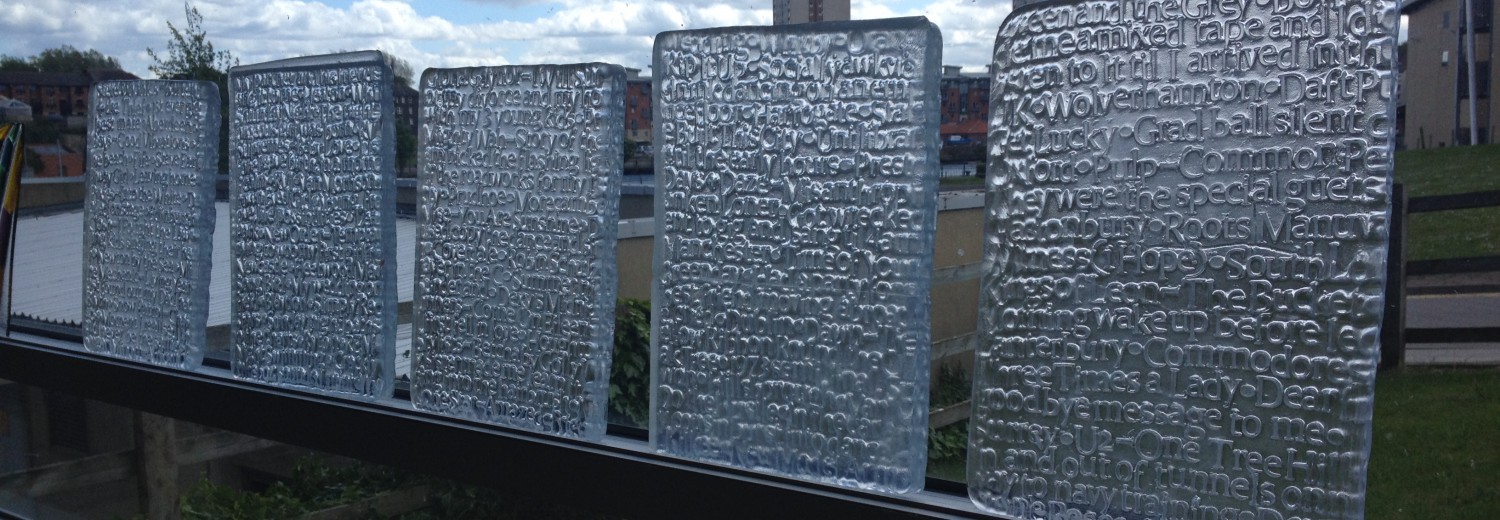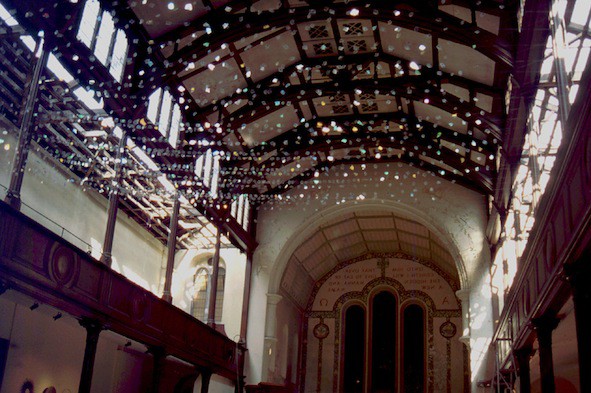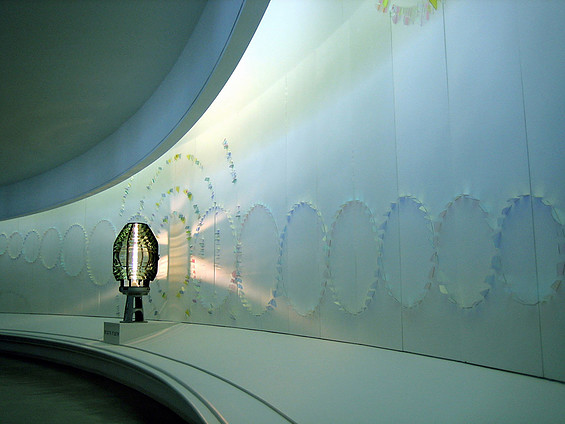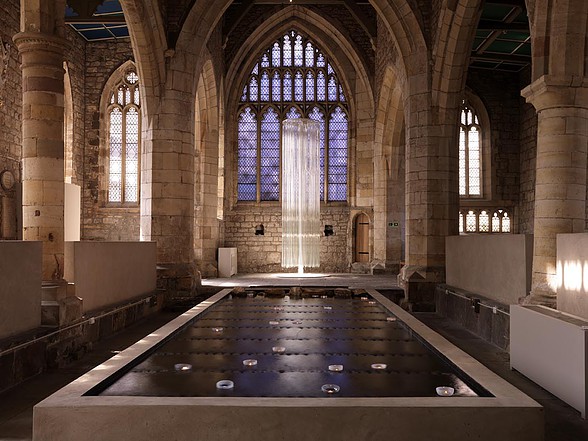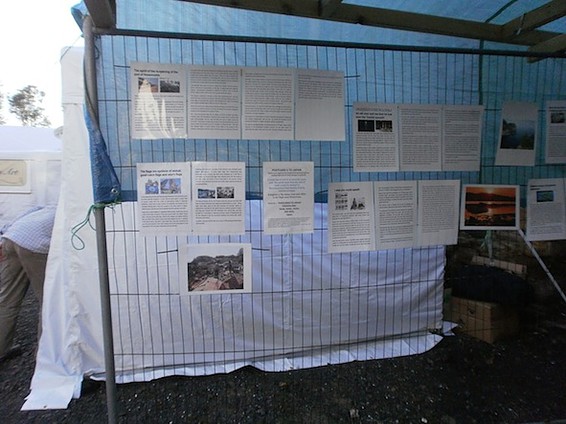Having been taught by Inge for over a year, my knowledge of her work was much broader than that of Keiko Mukaide’s. Yet I had not anticipated the scale of work she has developed throughout her career outside of the National Glass Centre.
Beginning the presentation on her general academic background, Panneels drew attention to her roots in Belgium and her move to the UK for her studies, which echoed the path of Mukaide.
After her time as a foundation student at Brighton where she developed her second language of English, Panneels moved to Scotland to study further in Edinburgh where she became interested in glass as an art medium over five years. Today she works as a freelance artist and academic and works on commission in order to make a living and get her work more widely visible.
Panneels’ early career makes her seem more relatable as an artist, as she explains how she needed to get commissions in order to make money and began getting herself known for selling her work to commercial spaces. With her first project came trial and error, which I’m sure every aspiring artist is only too familiar with. She created glass panels to decorate the Glasgow based Pizza Express restaurant, where she was able to experiment with display techniques.
Inge Panneels is well known in the art world for her glass art, which is heavily influenced by her interest in mapping. Much of her work includes maps, or is conceptually based on the idea of place. Perhaps this began with her 1999 work, Sense. At the Edinburgh office for British Telecom, Panneels created an interactive lighting glass piece, which worked with the movement of the busy corridor, possibly the basis of her development through mapping with this early tracking idea.
The use of light in Panneels work is obvious. She seems to take inspiration from the way light moves through the glass to create more than just an object, giving it depth and dimension. Her 1995 work in Stornoway, Circle of Light was intended to encourage public performances by its placement on the ground in the middle of the town. Once again this piece was made from painted glass with interactive lighting, which became brighter and more colourful at night. The light and shape of the piece was in reference to the building it was next to and its Gaelic roots.
Another piece commissioned in 2005, for the Orthopaedic Hospital in Shropshire was developed with the intention of highlighting the profound physical changes the patients were experiencing, through the artworks involvement of light and movement to reflect the rhythm of breathing. Panneels created Chrysalis to adorn a boring space and to give the bored and lonely patients something to admire.

It is evident from her portfolio that Panneels is not known for a particular technique in glass, as her more recent works explore a wide range of practices, with a wide range of glass types. Her work with Pate de Verre glass is enviable. Panneels is able to work with this type of glass mastering the kiln techniques needed to give her the desired outcomes. Using Pate de Verre and felting goat’s hair, Panneels was able to create the pieces, Egg and Sanctuary from the mixed media to represent forms of protection. As well as her experience with Pate de Verre, Panneels has also realised several artworks in cast glass.
Also experimenting with site specificity and installational work, Panneels worked with the Prestongrange Mining Museum to create, Souls in 2002. Working inside a Hoffman kiln, she echoed the loss of the industry by laying down over 400 candles inside to create an atmosphere of mourning and memory.
Panneels’ work with recycled glass could be considered another angle of mapping. She has reused glass to highlight the need to recycle materials in modern life to sustain the world around us. By gathering household glass jars and bottles, she was able to fill them with messages on luminescent paper for her piece, Message in a Bottle in 2006. Another artwork developed from this concept was 10 Green Bottles, using recycled glass bottles with recycling based facts engraved on them.
Panneels’ interest in mapping appears to be more of a recent realisation in her works. Focussing on genealogy as a concept she was able to research into the mapping of Scotland through DNA testing, incorporating both stories and the DNA into a map of a town. This is where we start to see the explosion of physical mapping.
Enlisting the help of assistants with computer experience, she is able to accurately develop plans to cut glass maps. Micro Macro was created using a waterjet cutter for the neat, accurate shapes and then fused. These panels represent the similarity of scale between the River Mersey Estuary and a blood vessel, connecting humans to earth. This piece went on to influence a whole series, titled Estuary.


Utilising the skilled people around her, Panneels is able to achieve a wider range of results in glass with their expertise in other areas. Her connections through the NGC have helped her realise accuracy in cutting with the use of the waterjet cutter, as well as the skilled hot glass department who have assisted in the making of murini cane for her work. Combining this cutting edge technology and a traditional handcraft, Panneels was able to create Mercator: Micro Macro. Wokring with contrasting scales and projection, Panneels create a large waterjet cut map and a tiny murini cane version from transparent and opaque glass.
The murini cane was then set in a silver ring, where Panneels could explore the concept of world power. Magic Earth (Mercator Ring) is intended to become an object for discussion, with the topic exploring what people would do with thirty seconds of world power. My own interest in combining glass and silver to create jewellery is something I wish to explore and yet I was unaware that Inge had already been discovering the possibilities.

Her marriage to an architect has been helpful to her mapping works, as she explains that her husband was able to assist her in plotting the floorplan of a site known only to her and not the viewer. The personal connection to Map of Someplace, Plan of Nowhere draws together her work in maps and her individual involvement in the concept.
Panneels’ most recent works focus on the landscape that is readily available to her in her home of Scotland. She is able to examine the important features of the setting, discovering the ruins left behind from the conflict of England and Scotland. Her 2015 research, Map-i, The Buchan Project was developed under her residency at the John Buchan Museum. Studying the novelist and his admiration of the Scottish Borders, Panneels is able to connect to the author and draw her own interpretations. To encourage people to the museum she was asked to create a paper map, which she executed on tracing paper to highlight the fact she would have loved to create interactive glass maps for the public.
Map-i is an ongoing body of work exploring the rich and vibrant community around her. She explains that her work is not about independent areas but a combination of glass, making, maps and the earth. It seems Panneels is currently endeavouring to create a body of work to draw attention to our surrounding and the earth that we live on and our modern lives in relation to mapping. Wanderers of the Earth; Walk, is a collaborative piece in response to a journey taken in the landscape. Physically connecting to the setting can often be very inspiring to make beautiful artwork and joining ideas with other artists can push your own ideas further than you imagined.

